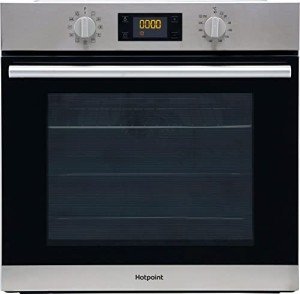What's The Job Market For Single Oven Electric Fan Professionals?
페이지 정보
작성자 Emmett 작성일 25-05-18 15:40 조회 14 댓글 0본문
What Is a Single Oven Electric Fan?
single oven electric fan oven single fan - click through the next article, is a form of cooking appliance that makes use of an internal fan to circulate hot air evenly across the oven cavity. This helps remove hot spots and enhance the overall cooking experience.
 Does your oven have fans? If yes, will it make certain areas of your oven hotter or cooler than others when you set the temperature?
Does your oven have fans? If yes, will it make certain areas of your oven hotter or cooler than others when you set the temperature?
Functions
Oven functions, also referred as cooking settings or cooking modes, offer a variety of oven options that have been pre-programmed to accommodate different recipes and cooking requirements. These features control the operation of heating elements and the fan in the oven, which allows for more precise and reliable results.
The majority of ovens are 'fan assisted which means that as the oven element heats up, fans circulate hot air in the oven cavity. This aids in cooking food. As a result, this function helps reduce the time it takes to preheat and allows for even cooking. In an oven, there are usually two fans: one that circulates hot air for cooking and another that cools down the oven. The cooling fan is controlled by a thermal switch. It will turn on automatically if the thermostat knob isn't set to off.
Functionality to make life easier
Ovens are able to be with a range of features that make them more comfortable to use, such as the defrost function that makes use of low heat to thaw foods without cooking them. This helps speed the process of defrosting and prevents dishes from becoming partially cooked or dry. The reheating feature is extremely useful, as it employs a gentle heating method to heat food items. This helps to retain the flavor and texture of the food.
A child lock feature secures the control panel to stop children from altering the settings or gaining access. The minute minder function is another feature that can be used independently of the cooking functions. It shuts off the oven when a certain amount of time has passed. This will help you avoid omitting to turn off the oven.
A multi-function oven is perfect for those who like to cook different dishes regularly. A fan oven that has a roast function lets you cook a variety of vegetables and meats simultaneously on several racks, making it ideal for Sunday lunches or meals with the whole family. There are grill and bake functions that make great additions to an attractive golden top to casseroles, potatoes, and cakes.
 Design
Design
Built in electric single gas oven ovens come in a range of sizes and styles to fit your kitchen and cooking requirements. Some models come with additional features, such as self-cleaning or delay start. These functions will save you time and effort. Read reviews to get an idea of the way these ovens are reviewed by other consumers.
A fan oven has a built-in air circulator which allows for more even cooking and faster results than traditional ovens. This is particularly useful when cooking dishes with a high fat content such as roasts and pies. The control panel will tell you if the oven is a fan-model. Look for an icon for a fan or a three-pronged fan encircled by the shape of a circle. Conventional ovens may be marked differently or not have fans at all.
Blomberg's A-rated integrated single oven and grill single oven has a large capacity of 71L. It is designed to perform and appearance. It comes with a variety of settings that include grill and fan-powered cookery. It also features a light-only mode to make cleaning simpler. It also has an adjustable clock/timer that can be programmed with a touch and an easy-clean enamel interior.
Energy Efficiency
Ovens are relatively low-energy appliances when compared to other household appliances such as refrigerators and air conditioners. However, the type of oven and cooking method used can still significantly impact energy costs. A lot of the modern single electric fan oven with grill ovens are more energy efficient than older models. This reduces energy consumption, saving you money on your utility bill.
The main difference between a traditional and fan oven is that a traditional oven uses only one heating element, while fan ovens have an element for Single oven electric fan heating as well as a fan to circulate hot air around the food. By using a fan, you can use lower temperatures, which reduces energy use. Additionally, a fan can reduce baking time.
A brushless DC motor is a different option to ensure that you are getting the most efficient single oven with grill electric oven electric fan. This motor technology is more efficient than older, non-brushless models. It also reduces noise levels.
You can find the energy rating on the appliance's manual or somewhere else. This number will provide you with an idea of the amount of energy the oven consumes operating. You can then compare it to the cost per kWh of your local electricity tariff, which can vary greatly based on the area you live in.
There are several elements that can impact the overall energy consumption of an oven, including the kind of food you're cooking and the temperature setting and the length of time you cook it for. The cooking process itself may also affect how much electricity it consumes in the same way that preheating the oven before using it.
To maximize the efficiency of your oven shut it off when you've finished using it and keep track of your usage. Smart meters can provide you with precise information on the amount of energy your appliances consume. You can also explore other cooking methods that use less energy.
Installation
There are costs to consider when replacing or installing an electric fan-oven, whether it's the first time or not. These range from removing and disposing of the old appliance to the installation or upgrading of outlets and utilities lines. It is also possible to install an exhaust hood if your new unit requires it. Labor rates vary between contractors, so you should shop around to find the best price.
You can tell if the oven has fans by looking at the control panel. The fact that it has fans means that air circulates continuously within the oven's chamber, allowing it to reach temperature quicker and distribute heat evenly. On the control panel of traditional ovens, you may see a different icon or no fan icon.
You should examine the wiring of the old unit prior to hiring an electrician. It's easy for a professional electrician to connect the appliance to your wiring system if the older one plugs directly into a power outlet. If the older oven is hard-wired to your circuit breaker, or switchbox this is more difficult. If the new unit is higher in watts than the previous one, you'll have to make sure that your circuit breakers are able to handle the additional current. It is also important to ensure that any cables that are used are of sufficient size.
Installation costs will also vary according to where your kitchen is located in your home. A freestanding oven that is able to be easily moved from room to room is less expensive than a wall-mounted unit which must be cut into countertop or cabinetry to install. You should also factor in the cost of additional equipment if you have to run electricity or gas lines or ductwork for ventilation.
If you're replacing an appliance that is already in place, an electric oven installation should not cost more than $70 to $155. The addition of a new outlet in the kitchen will increase the price by about $200, while installing a vent hood will add around $300.
single oven electric fan oven single fan - click through the next article, is a form of cooking appliance that makes use of an internal fan to circulate hot air evenly across the oven cavity. This helps remove hot spots and enhance the overall cooking experience.
 Does your oven have fans? If yes, will it make certain areas of your oven hotter or cooler than others when you set the temperature?
Does your oven have fans? If yes, will it make certain areas of your oven hotter or cooler than others when you set the temperature?Functions
Oven functions, also referred as cooking settings or cooking modes, offer a variety of oven options that have been pre-programmed to accommodate different recipes and cooking requirements. These features control the operation of heating elements and the fan in the oven, which allows for more precise and reliable results.
The majority of ovens are 'fan assisted which means that as the oven element heats up, fans circulate hot air in the oven cavity. This aids in cooking food. As a result, this function helps reduce the time it takes to preheat and allows for even cooking. In an oven, there are usually two fans: one that circulates hot air for cooking and another that cools down the oven. The cooling fan is controlled by a thermal switch. It will turn on automatically if the thermostat knob isn't set to off.
Functionality to make life easier
Ovens are able to be with a range of features that make them more comfortable to use, such as the defrost function that makes use of low heat to thaw foods without cooking them. This helps speed the process of defrosting and prevents dishes from becoming partially cooked or dry. The reheating feature is extremely useful, as it employs a gentle heating method to heat food items. This helps to retain the flavor and texture of the food.
A child lock feature secures the control panel to stop children from altering the settings or gaining access. The minute minder function is another feature that can be used independently of the cooking functions. It shuts off the oven when a certain amount of time has passed. This will help you avoid omitting to turn off the oven.
A multi-function oven is perfect for those who like to cook different dishes regularly. A fan oven that has a roast function lets you cook a variety of vegetables and meats simultaneously on several racks, making it ideal for Sunday lunches or meals with the whole family. There are grill and bake functions that make great additions to an attractive golden top to casseroles, potatoes, and cakes.
 Design
DesignBuilt in electric single gas oven ovens come in a range of sizes and styles to fit your kitchen and cooking requirements. Some models come with additional features, such as self-cleaning or delay start. These functions will save you time and effort. Read reviews to get an idea of the way these ovens are reviewed by other consumers.
A fan oven has a built-in air circulator which allows for more even cooking and faster results than traditional ovens. This is particularly useful when cooking dishes with a high fat content such as roasts and pies. The control panel will tell you if the oven is a fan-model. Look for an icon for a fan or a three-pronged fan encircled by the shape of a circle. Conventional ovens may be marked differently or not have fans at all.
Blomberg's A-rated integrated single oven and grill single oven has a large capacity of 71L. It is designed to perform and appearance. It comes with a variety of settings that include grill and fan-powered cookery. It also features a light-only mode to make cleaning simpler. It also has an adjustable clock/timer that can be programmed with a touch and an easy-clean enamel interior.
Energy Efficiency
Ovens are relatively low-energy appliances when compared to other household appliances such as refrigerators and air conditioners. However, the type of oven and cooking method used can still significantly impact energy costs. A lot of the modern single electric fan oven with grill ovens are more energy efficient than older models. This reduces energy consumption, saving you money on your utility bill.
The main difference between a traditional and fan oven is that a traditional oven uses only one heating element, while fan ovens have an element for Single oven electric fan heating as well as a fan to circulate hot air around the food. By using a fan, you can use lower temperatures, which reduces energy use. Additionally, a fan can reduce baking time.
A brushless DC motor is a different option to ensure that you are getting the most efficient single oven with grill electric oven electric fan. This motor technology is more efficient than older, non-brushless models. It also reduces noise levels.
You can find the energy rating on the appliance's manual or somewhere else. This number will provide you with an idea of the amount of energy the oven consumes operating. You can then compare it to the cost per kWh of your local electricity tariff, which can vary greatly based on the area you live in.
There are several elements that can impact the overall energy consumption of an oven, including the kind of food you're cooking and the temperature setting and the length of time you cook it for. The cooking process itself may also affect how much electricity it consumes in the same way that preheating the oven before using it.
To maximize the efficiency of your oven shut it off when you've finished using it and keep track of your usage. Smart meters can provide you with precise information on the amount of energy your appliances consume. You can also explore other cooking methods that use less energy.
Installation
There are costs to consider when replacing or installing an electric fan-oven, whether it's the first time or not. These range from removing and disposing of the old appliance to the installation or upgrading of outlets and utilities lines. It is also possible to install an exhaust hood if your new unit requires it. Labor rates vary between contractors, so you should shop around to find the best price.
You can tell if the oven has fans by looking at the control panel. The fact that it has fans means that air circulates continuously within the oven's chamber, allowing it to reach temperature quicker and distribute heat evenly. On the control panel of traditional ovens, you may see a different icon or no fan icon.
You should examine the wiring of the old unit prior to hiring an electrician. It's easy for a professional electrician to connect the appliance to your wiring system if the older one plugs directly into a power outlet. If the older oven is hard-wired to your circuit breaker, or switchbox this is more difficult. If the new unit is higher in watts than the previous one, you'll have to make sure that your circuit breakers are able to handle the additional current. It is also important to ensure that any cables that are used are of sufficient size.
Installation costs will also vary according to where your kitchen is located in your home. A freestanding oven that is able to be easily moved from room to room is less expensive than a wall-mounted unit which must be cut into countertop or cabinetry to install. You should also factor in the cost of additional equipment if you have to run electricity or gas lines or ductwork for ventilation.
If you're replacing an appliance that is already in place, an electric oven installation should not cost more than $70 to $155. The addition of a new outlet in the kitchen will increase the price by about $200, while installing a vent hood will add around $300.









